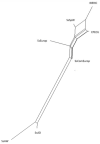A Matrilineal Study on the Origin and Genetic Relations of the Ecuadorian Pillareño Creole Pig Population through D-Loop Mitochondrial DNA Analysis
- PMID: 34828053
- PMCID: PMC8614550
- DOI: 10.3390/ani11113322
A Matrilineal Study on the Origin and Genetic Relations of the Ecuadorian Pillareño Creole Pig Population through D-Loop Mitochondrial DNA Analysis
Abstract
Domestic pig breeds reached America on the second Columbus trip; from this date, Iberian pig genetic resources were disseminated throughout the continent, forming diverse creole breeds. These Ecuadorian Creole pigs are important for food production but have been genetically eroded since the introduction of transboundary breeds. In this study, we sought to characterize this erosion more thoroughly through mitochondrial DNA D-Loop analysis of Ecuadorian Pillareño Creole pigs from seven regions of Ecuador. To allow comparison, we also included in our analysis sequences from wild species, commercial lines, and domestic pigs, which were obtained from the NCBI GenBank database. Creole pigs' population showed overall moderate Hd values and low π values, and a negative value of Tajima's D was observed. The greatest differentiation from the Ecuadorian Pillareño Creole pigs was observed between Asian wild and Asian domestic pigs. The haplotype analysis revealed three different phylogenetic clades (A, E I, and E II) and 65 haplotypes. Ecuadorian Creole populations were grouped into nine haplotypes for Clade E I and E II, which have not previously been reported for Creole Pillareño populations. Our analysis indicates that in the establishment of Creole Pillareño pigs, individuals most likely separated from the Asian pig population and appear to be genetically influenced by European and Iberian populations raised in Spain.
Keywords: DNA D-loop; Tajima’s D; creole pigs; separated.
Conflict of interest statement
The authors declare no conflict of interest.
Figures


References
-
- Canales Vergara A.M., Landi V., Delgado Bermejo J.V., Martínez A., Cervantes Acosta P., Pons Barro Á., Bigi D., Sponenberg P., Helal M., Hossein Banabazi M. Tracing worldwide turkey genetic diversity using D-loop sequence mitochondrial DNA analysis. Animals. 2019;9:897. doi: 10.3390/ani9110897. - DOI - PMC - PubMed
LinkOut - more resources
Full Text Sources
Research Materials
Miscellaneous

